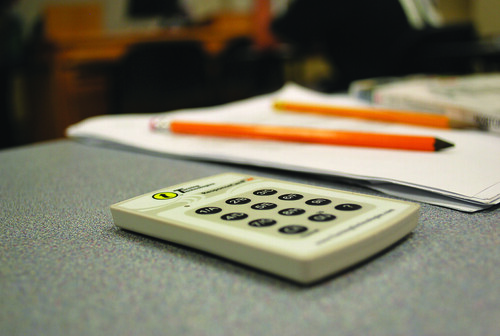Temple’s Teaching and Learning Center introduces clickers to make lectures more interactive.
When incoming freshmen attended the Tuttleman Counseling Center’s workshop at Temple’s new-student orientation, they were given clickers to answer questions anonymously about sensitive issues, such as alcohol and sex, to instantaneously generate an anonymous survey. For many students, orientation was not their first encounter with the clickers, and it will most likely not be their last.

The remote control-like devices are assigned to students through an ID number and can be used to answer questions during lectures. Temple is actively working to incorporate them into more classrooms.
Research has been done to suggest the effectiveness of clickers. Their proponents refer to Richard Hake’s 1998 study of 6,000 students.
Results of the study showed that, in traditional lecture settings, students only learned 25 percent of what they could have, while in interactive-engagement courses, students retained a range of 25 percent to 75 percent of the information.
Dr. Stephanie Fiore, associate director of the Teaching and Learning Center and professor of Italian, facilitated a workshop called “Clicking Your Way to an Interactive Lecture.” The workshop, which was designed to demonstrate how to use clickers effectively and interactively in large classrooms, was open to Temple faculty on Wednesday, Sept. 22 and Thursday, Sept. 23.
Clickers can be used to take attendance and formally quiz students, but Fiore warned against these methods since they do not make the best use of the clickers and are not their intended functions.
“The best use of clickers is really to stimulate thinking about concepts and discussion on concepts, so that students [and professors] can figure out whether they understand what’s going on,” Fiore said.
This summer, assistant professor of geology Dr. Alexandra Davatzes learned about clickers in a similar, geology-specific workshop. She recently began using clickers in her Evolutions and Extinctions lecture, which includes more than 100 students.
Davatzes explained that her purpose for using the clickers is to encourage more students to participate by asking them questions on the material. She said she has been pleasantly surprised the effect they’ve had.
By using them one or two times per lecture, she says the class participates much more. Davatzes attributes the success of clickers to their anonymity.
“I think [students] like the instant feedback that they know they’ve got the right answer before they volunteer to talk more about it,” Davatzes said.
She has found that students are likely to commit to an answer when they are not dreading the embarrassment of publicly guessing incorrectly. Without clickers, students tend to passively let someone else answer the question.
Since the clickers are registered to each student, the professor knows who clicks in and who does not. Participation points are awarded accordingly, but there is no penalty or embarrassment for an incorrect answer.
While many attest to the clickers’ positive impact in the classroom, advocacy is not universal. Journalism professor Christopher Harper rejected the idea of incorporating clickers into his lectures.
While he is a firm believer in technology, Harper puts an even greater emphasis on content.
“I don’t see any real advantage to clickers,” Harper said.
Dan Sabato, a freshman secondary education and history major, said the first time he was exposed to the clickers was in his Evolutions and Extinctions class. He finds himself sympathetic to Harper’s apathy.
“They don’t really seem to change it either way,” Sabato said.
Data on the number of people using clickers are unavailable, but the number is growing in the sense that there is an augmented interest in the subject.
“Professors are starting to understand that if they shift how they do lecture, it just becomes a much richer experience for their students,” Fiore said. “And they’re willing to try that.”
Haley Kmetz can be reached at haley.kmetz@temple.edu.



Be the first to comment